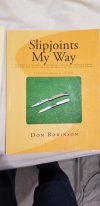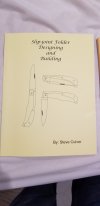TUTORIAL POST #2
The intention of this post is to cover tooling for the project. I will provide my opinions on each item. I invite others to do the same. Hopefully this post will help people get properly equipped to take on the slipjoint. Some items are nice while others are required. If I missed anything let me know.
OK, first up is a surface grinder. In my opinion this is the biggest financial hurdle involved in making slipjoints. I personally use an Oregon blade maker surface grinder attachment paired with my kmg. I am in the process of restoring a 50's vintage surface grinder, but I have yet to try it out. I do believe that Oregon blade maker goes by a different name now. I know these attachments can be frowned upon by elitists but mine has yet to steer me wrong. It is also nice to get a belt finish (no hand sanding required). This attachment is designed to work with their own grinders but it also works with my kmg, no modifications needed. I cant speak for other grinders compatibility but hopefully someone else can weigh in. The TW unit seems very nice as well but it is a lot more expensive. If you have room for a dedicated unit and you can source one this is likely the best option.
Here is a link to the attachment I use
https://originblademaker.com/product/belt-grinder-2x72-attachment/
As with any Surface grinder you need to take small bites. There are certain techniques involved in using this to its fullest potential which I will detail in that part of the tutorial. I do imagine this can be done without a surface grinder but it will suck. Hopefully someone with experience can comment. If you plan to do this without one You will need a granite surface plate and some patience. You will need precision stock. It is paramount that both the spring and blade are flat and parallel, they also need to be the exact same thickness. If you can accomplish this without a surface grinder then your good to go, also I am scared of you. Anyone with that level of patience should not be messed with.
Next is the grinder itself (and lots of belts). Pretty much any grinder will do. Grinders are like trucks, it seems everyone has their favorite. I don't think you can go wrong with any brand name 2x72. you can get away with a 1x30 if you want. the slipjoint doesn't really need high horsepower. As with the surface grinder you could use hand tools. you can file the bevels and profile manually. I wont speak much to this because I have never tried it.
Bandsaw next. I have a 64.5inch saw that I like. I know others have used portabands with great success. I am assuming that if your looking into this you already have made some fixed blades. Nothing new here. If anyone wants more info on bandsaws I will expand this section. One piece of advice I will give is not to attempt to use a cheap wood cutting bandsaw. Get one that is designed to cut metal. Again, you can do this by hand if need be. You can use a hacksaw or an angle grinder.
Drill press. You will need to put holes in your knife. This, in my opinion is the first mandatory item. I will explain why later on in the tutorial. Luckily you don't need an expensive machine. I use a WEN drill press that I got off amazon, delivered to my door for about $100 CAD.
123 Blocks. Also mandatory in my opinion. These are cheap. Get some, you will find a million uses for these.
You will need some drill bits as well that are specific to this project. Luckily to complete the knife in the CAD file you will only need 2 sizes (3/32" and a #41). This is directly out of Don Robinsons book. I will elaborate later, but basically 3/32 is .0937" and a #41 is .0960. These two sizes allow you to counterbore for peening at the end as well as give you a little extra room in your pivot. If you read his book he explains it well. Get a few of each. High speed steel is fine no need to splurge for carbide. I sourced mine from McMaster Carr. If your really a perfectionist you could get a 3/32" reamer but I don't think it is necessary.
A RFI (rise and fall indicator) is nice to have but not required. you can make your own (refer to AR customs videos) or purchase one. I elected to purchase one from USA knifemaker. Theirs is great because it has the ability to simulate spring tension. I will explain this in the tutorial. It will save some time and makes the overall experience more enjoyable.
here is a link
https://usaknifemaker.com/rise-fall-indicator-premium-knifedogs-brand-tool.html
This indicator is designed to work with the 3/32" pins used in this build. No modification required. It may seem expensive but this is not a mass produced item. Also USA knifemaker is awesome and deserves support (in my opinion).
A set of calipers couldn't hurt. Not mandatory but nice to have.
A small ball peen hammer. Don Robinson recommends 1/4lb so that's what I got. Knowing what I know now I would say that any small hammer will work for this.
Optical center punch. This is required. Your holes need to be bang on and this is the best way (short of a milling machine) to accomplish this that I am aware of. I have a cheap one that I got off ebay. expect to spend $50 to $100 for a basic one. If anyone knows a workaround let me know, but as far as I can tell if you attempt this without one it could be frustrating. For the sake of your sanity I would get a cheap one.
Files. Get files. you will need at least one flat file and one small triangular file. You get what you pay for here.
OK, im pretty sure that covers the tools specific to this project. (im sure I missed some, I will edit this post as needed)


